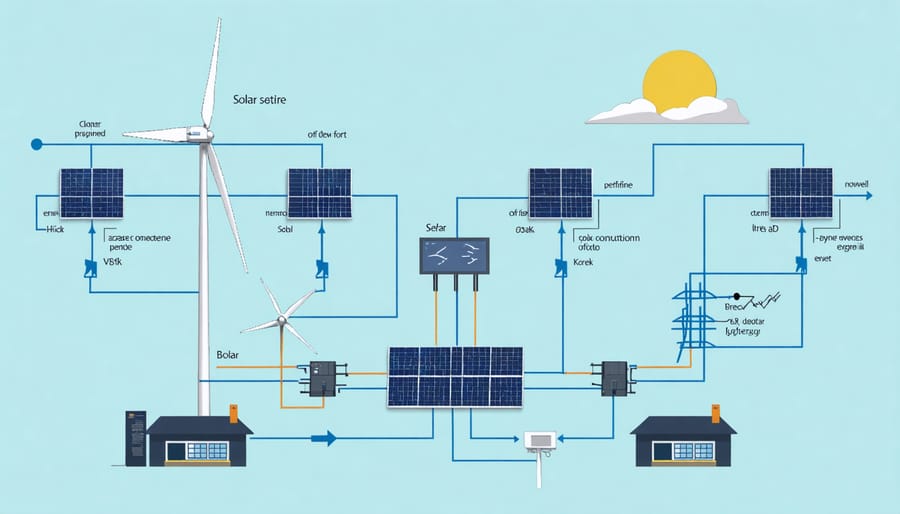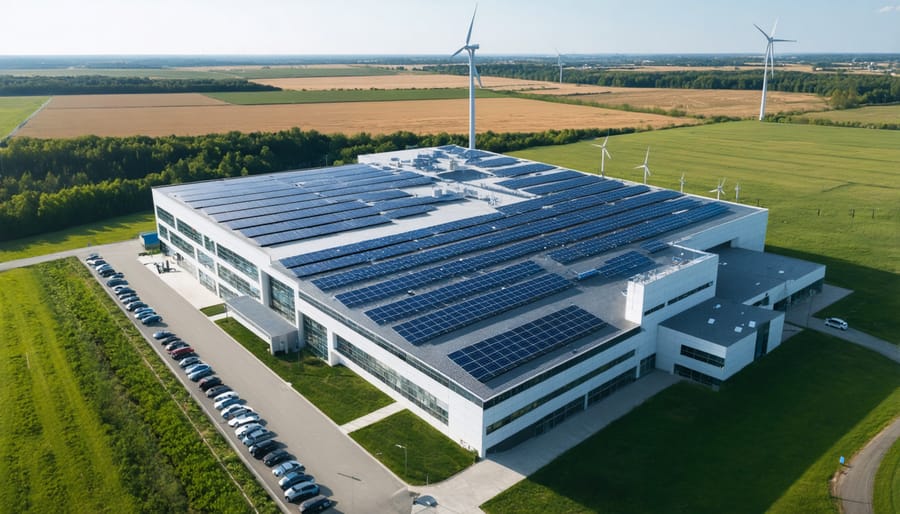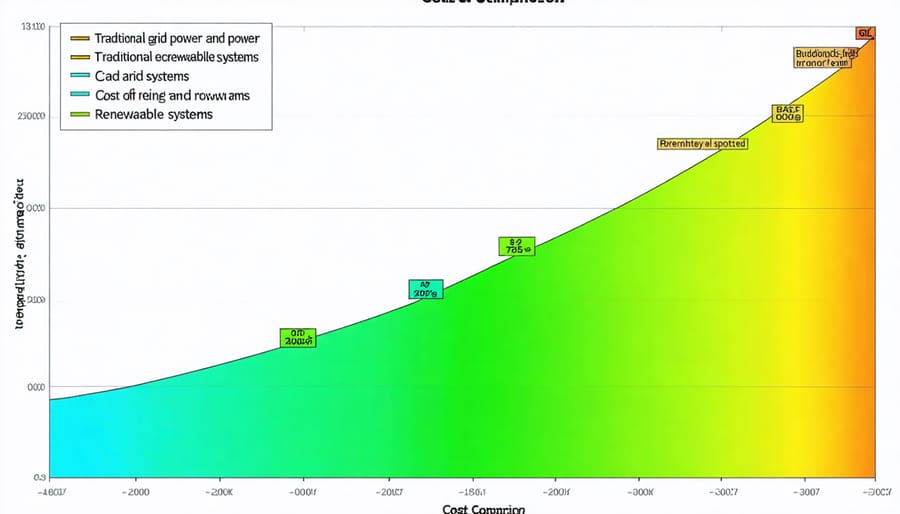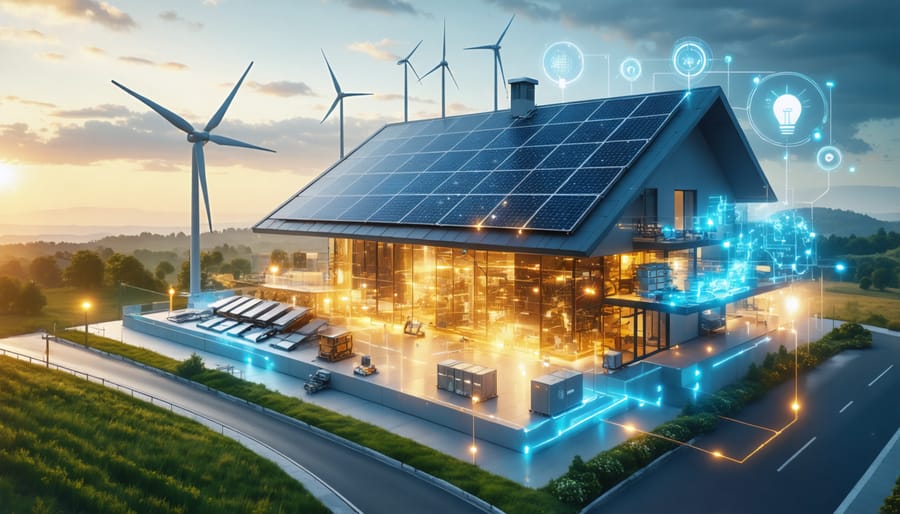Off-grid renewable energy systems represent a transformative shift in how we power buildings and communities beyond traditional utility infrastructure. These autonomous power solutions combine solar panels, wind turbines, energy storage systems, and smart controls to deliver reliable electricity without grid dependency. As construction costs decrease and energy security concerns rise, off-grid systems have evolved from remote cabin solutions to viable alternatives for commercial buildings, manufacturing facilities, and entire communities.
The integration of advanced battery technology, predictive analytics, and hybrid power management systems has dramatically improved system reliability while reducing operational complexity. Modern off-grid installations achieve 99.9% uptime through sophisticated load management and redundant power sources, matching or exceeding grid reliability in many regions. This technological maturity, combined with falling equipment costs and increased energy density in storage solutions, has created compelling economic cases for off-grid implementation across diverse applications.
For construction professionals and project developers, understanding these systems’ technical requirements, component integration, and operational characteristics is crucial for successful deployment. This comprehensive guide examines the critical elements of off-grid renewable energy systems, from initial site assessment through long-term maintenance, providing essential insights for informed decision-making and optimal system performance.

Core Components of Off-Grid Renewable Systems
Energy Generation Technologies
Modern off-grid renewable energy systems primarily rely on solar photovoltaic (PV) technology as the cornerstone of power generation. Solar PV panels convert sunlight directly into electricity through semiconductor materials, offering reliable performance with minimal maintenance requirements. These systems typically achieve efficiency rates between 15-22%, depending on panel quality and environmental conditions.
Wind turbines serve as an excellent complementary technology, particularly in locations with average wind speeds exceeding 12 mph. Small-scale wind systems, ranging from 1-10 kW, can be mounted on towers 30-140 feet tall and are especially effective in rural or coastal areas. Modern turbines incorporate advanced blade designs and smart controllers to optimize energy capture.
Other viable generation methods include micro-hydro systems for properties with flowing water sources, capable of providing consistent baseload power with efficiency rates up to 90%. Biomass generators, while less common, offer reliable backup power using organic materials. Some installations successfully combine multiple technologies, such as solar-wind hybrid systems, to enhance generation reliability across varying weather conditions and seasons.
When selecting generation technologies, factors such as site characteristics, local resource availability, and peak load requirements must guide the decision-making process.
Energy Storage Solutions
Effective energy storage solutions are crucial for maintaining consistent power supply in off-grid renewable systems. Modern lithium-ion battery systems offer high energy density and extended cycle life, making them ideal for commercial and residential applications. These systems typically provide 10-15 years of reliable service when properly maintained and can achieve round-trip efficiencies exceeding 90%.
Thermal storage technologies, including molten salt and phase-change materials, complement battery systems by managing heating and cooling loads more efficiently. These solutions can reduce peak demand and optimize energy utilization during non-generating hours. Recent innovations in flow batteries and hydrogen storage are expanding the possibilities for long-duration storage, particularly beneficial for seasonal variations in renewable energy generation.
Advanced battery management systems (BMS) integrate seamlessly with building automation controls, enabling real-time monitoring and predictive maintenance. This integration ensures optimal performance and extends system longevity while maintaining stable power quality. For maximum reliability, hybrid storage configurations combining different technologies are becoming increasingly common in large-scale installations, offering redundancy and enhanced system resilience.
Control and Management Systems
Modern off-grid renewable energy systems rely heavily on sophisticated smart energy management systems to optimize performance and maintain system stability. These controllers integrate multiple power sources, managing the flow between solar panels, wind turbines, and battery storage while monitoring real-time energy production and consumption patterns. Advanced monitoring equipment provides detailed analytics on system performance, component health, and maintenance requirements through user-friendly interfaces. System integration protocols ensure seamless communication between different components, enabling automated load management and predictive maintenance capabilities. Industrial-grade SCADA systems can be implemented for larger installations, offering comprehensive control over power distribution, while smaller systems benefit from compact, programmable logic controllers that maintain optimal system efficiency and protect against electrical anomalies.
Design Considerations and Implementation
Load Analysis and System Sizing
Accurate load analysis and system sizing are crucial steps in designing effective off-grid renewable energy systems, particularly for zero energy buildings. The process begins with a comprehensive energy audit to determine daily, monthly, and seasonal power requirements. Engineers must calculate both average and peak loads, accounting for all electrical appliances, HVAC systems, and other power-consuming equipment.
The system’s capacity is determined using the following key factors:
– Daily energy consumption (kWh/day)
– Peak power demand (kW)
– System losses and efficiency factors
– Weather patterns and seasonal variations
– Battery storage requirements
– Future load growth projections
A safety factor of 15-20% is typically added to accommodate unexpected power demands and system degradation over time. For solar PV systems, the array size is calculated by dividing the daily energy requirement by the location’s peak sun hours, then adjusting for system losses. Battery bank capacity should provide 2-3 days of autonomy, considering depth of discharge limitations and temperature effects.
Professional load analysis software and monitoring tools can help optimize system sizing, while detailed load schedules and usage patterns ensure accurate capacity planning. Regular reassessment of power requirements enables system adaptability to changing needs over time.
Site Assessment and Installation Requirements
A successful off-grid renewable energy system requires thorough site assessment and careful consideration of installation requirements. Key factors include solar exposure analysis, which evaluates annual sun paths, shading patterns, and potential obstructions. Wind resource assessment involves measuring average wind speeds, directional patterns, and turbulence factors at various heights.
Topographical considerations affect both solar and wind installations, with slope gradient, soil stability, and drainage patterns influencing foundation requirements and equipment placement. Environmental factors such as extreme weather conditions, salt exposure in coastal areas, and wildlife impact must be evaluated during the planning phase.
Installation requirements encompass structural integrity assessment of existing buildings, access routes for equipment delivery, and space allocation for battery storage systems. Local building codes and zoning regulations often dictate setback requirements, height restrictions, and safety measures. Additionally, proper grounding systems, lightning protection, and weatherproofing must be implemented according to regional specifications.
Professional site surveys should include detailed electrical load analysis, equipment spacing requirements, and maintenance access planning to ensure optimal system performance and longevity.

Regulatory Compliance and Safety Standards
Off-grid renewable energy systems must comply with various national and local regulations to ensure safe operation and reliable performance. The National Electrical Code (NEC) Article 690 provides specific requirements for solar photovoltaic systems, while Article 694 covers wind electric systems. These codes establish essential guidelines for system design, installation, and maintenance.
Key safety standards include proper grounding requirements, overcurrent protection, disconnect mechanisms, and appropriate labeling of system components. All electrical work must be performed by certified professionals and undergo inspection by local authorities having jurisdiction (AHJ).
Battery storage systems must adhere to specific ventilation requirements and safety protocols outlined in NEC Article 480. Additionally, structural considerations for roof-mounted solar panels must comply with local building codes and wind load requirements.
Projects must also consider environmental regulations, particularly in sensitive areas. Permits are typically required for installation, and system documentation must be maintained for compliance verification. Regular safety inspections and maintenance schedules should be established to ensure ongoing compliance with applicable standards.
Many jurisdictions now require specific certifications for renewable energy installers, such as the North American Board of Certified Energy Practitioners (NABCEP) certification.
Cost Analysis and ROI
Initial Investment Considerations
The initial investment for off-grid renewable energy systems varies significantly based on system capacity, site conditions, and energy requirements. A comprehensive residential system typically ranges from $30,000 to $100,000, while commercial installations can exceed $500,000. The largest cost components include solar panels ($2-3 per watt), battery storage systems (25-40% of total cost), and inverters (10-15% of total cost).
Installation expenses encompass site preparation, mounting structures, wiring, and labor costs, typically accounting for 20-30% of the total investment. Additional considerations include permits, engineering assessments, and grid-disconnection procedures, which can add 5-10% to the overall cost.
Energy storage solutions represent a crucial cost factor, with lithium-ion batteries ranging from $5,000 to $15,000 for residential systems and significantly more for commercial applications. Backup generators, while optional, add $3,000-$7,000 to the initial investment.
Professional design and engineering services typically cost 5-8% of the total budget but are essential for system optimization and compliance with local regulations. Regular maintenance costs should also be factored into the long-term financial planning.
Long-term Benefits and Savings
Implementing off-grid renewable energy systems yields substantial long-term financial and environmental advantages. Studies show that these systems can deliver significant renewable energy cost savings, with most installations achieving complete return on investment within 5-8 years. Operating costs typically decrease by 60-80% compared to grid-dependent systems, primarily through eliminated utility bills and reduced maintenance requirements.
Beyond financial benefits, these systems significantly reduce carbon footprints. Analysis from the International Renewable Energy Agency (IRENA) indicates that a typical commercial off-grid installation can prevent 15-20 metric tons of CO2 emissions annually. This environmental advantage often translates into additional financial benefits through carbon credits and environmental compliance certifications.
The durability of modern renewable components, with solar panels lasting 25-30 years and advanced battery systems maintaining 80% capacity after 10 years, ensures sustained operational savings. When combined with smart energy management systems, these installations can optimize energy consumption patterns, further maximizing efficiency and extending equipment lifespan.

Available Incentives and Funding Options
Several financial incentives are available to support off-grid renewable energy installations. Federal tax credits currently offer up to 30% of system costs for solar and wind installations, while state-specific programs provide additional rebates and grants. The Rural Energy for America Program (REAP) offers grants covering up to 25% of project costs for agricultural producers and rural small businesses. Commercial property owners can leverage Modified Accelerated Cost Recovery System (MACRS) depreciation benefits. Many utilities offer performance-based incentives and net metering programs. Financial institutions increasingly provide specialized green loans and energy improvement mortgages with favorable terms. Local governments may also offer property tax exemptions and expedited permitting for off-grid systems.
Case Study: Successful Implementation
The Riverfront Business Center in Portland, Oregon, stands as a compelling example of successful off-grid renewable energy implementation in a commercial setting. This 45,000-square-foot office complex, completed in 2019, demonstrates how thoughtful system design and integration can achieve complete energy independence while maintaining reliable operations.
The building utilizes a hybrid system combining solar photovoltaic arrays and wind turbines. The rooftop houses a 200kW solar array consisting of 625 high-efficiency panels, while three 20kW vertical axis wind turbines are strategically positioned to capture prevailing winds from the Columbia River. This combination ensures consistent power generation across varying weather conditions and seasons.
Energy storage is managed through a sophisticated 500kWh lithium-ion battery system, complemented by hydrogen fuel cells for long-term backup. The building’s smart energy management system optimizes power distribution and consumption, automatically adjusting HVAC operations and lighting based on occupancy and weather patterns.
The project’s initial investment of $2.8 million was offset by various incentives, including federal tax credits and state renewable energy grants, reducing the net cost to $1.9 million. The system achieved complete return on investment within 6.5 years, primarily through eliminated utility costs and revenue from excess power sales during peak generation periods.
Key performance metrics after three years of operation include:
– 98.7% system reliability
– 285,000 kWh annual energy production
– 40% reduction in building operating costs
– Zero carbon emissions
– 95% tenant satisfaction rate
The success of this implementation has led to the building becoming a model for sustainable commercial construction in the Pacific Northwest, with the property maintaining full occupancy and commanding premium lease rates. The project demonstrates that off-grid systems can be both technically feasible and financially viable for commercial applications when properly designed and executed.
As the construction industry continues to evolve, off-grid renewable energy systems have emerged as a crucial component in sustainable building development. The integration of these systems has demonstrated significant benefits, from reducing operational costs and environmental impact to enhancing building resilience and energy independence.
The successful implementation of off-grid solutions relies on careful planning, appropriate technology selection, and comprehensive system design. As evidenced by numerous case studies and industry examples, buildings utilizing these systems can achieve remarkable energy efficiency while maintaining reliable power supply through various environmental conditions.
Looking ahead, the future of off-grid renewable energy systems appears increasingly promising. Technological advancements in energy storage solutions, solar panel efficiency, and smart control systems continue to improve system performance while reducing implementation costs. The growing focus on sustainable construction practices and stricter environmental regulations will likely accelerate the adoption of these systems across various building types.
However, challenges remain in terms of initial investment costs and technical expertise requirements. Industry professionals must stay informed about evolving technologies, regulations, and best practices to effectively implement these systems. As the market matures and technology costs decrease, we can expect to see wider adoption of off-grid renewable energy systems, particularly in remote locations and areas with unreliable grid connections.
The transition toward energy-independent buildings represents not just a trend but a fundamental shift in construction industry practices, promising a more sustainable and resilient built environment for future generations.

